Substantial contribution of the two imidazole rings of the His13-His14 dyad to Cu(II) binding in amyloid-β(1-16) at physiological pH and its significance
- PMID: 21491887
- PMCID: PMC3155642
- DOI: 10.1021/jp200379m
Substantial contribution of the two imidazole rings of the His13-His14 dyad to Cu(II) binding in amyloid-β(1-16) at physiological pH and its significance
Abstract
The interaction of amyloid-β (Aβ) peptide with Cu(II) appears to play an important role in the etiology of Alzheimer's disease. At physiological pH, the Cu(II) coordination in Aβ is heterogeneous, and there exist at least two binding modes in which Cu(II) is coordinated by histidine residues. Electron spin resonance studies have revealed a picture of the Cu(II) binding at a higher or lower pH, where only one of the two binding modes is almost exclusively present. We describe a procedure to directly examine the coordination of Cu(II) to each histidine residue in the dominant binding mode at physiological pH. We use nonlabeled and residue-specifically (15)N-labeled Aβ(1-16). For quantitative analysis, the intensities of three-pulse electron spin-echo envelope modulation (ESEEM) spectra are analyzed. Spectral simulations show that ESEEM intensities provide information about the contribution of each histidine residue. Indeed, the ESEEM experiments at pH 6.0 confirm the dominant contribution of His6 to the Cu(II) coordination as expected from the work of other researchers. Interestingly, however, the ESEEM data obtained at pH 7.4 reveal that the contributions of the three residues to the Cu(II) coordination are in the order of His14 ≈ His6 > His13 in the dominant binding mode. The order indicates a significant contribution from the simultaneous coordination by His13 and His14 at physiological pH, which has been underappreciated. These findings are supported by hyperfine sublevel correlation spectroscopy experiments. The simultaneous coordination by the two adjacent residues is likely to be present in a non-β-sheet structure. The coexistence of different secondary structures is possibly the molecular origin for the formation of amorphous aggregates rather than fibrils at relatively high concentrations of Cu(II). Through our approach, precise and useful information about Cu(II) binding in Aβ(1-16) at physiological pH is obtained without any side-chain modification, amino acid residue replacement, or pH change, each of which might lead to an alteration in the peptide structure or the coordination environment.
© 2011 American Chemical Society
Figures


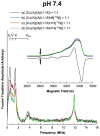
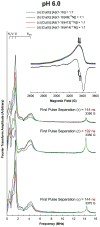
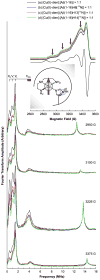
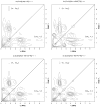
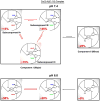
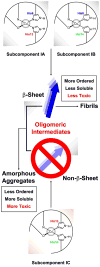
Similar articles
-
Direct evidence that all three histidine residues coordinate to Cu(II) in amyloid-beta1-16.Biochemistry. 2008 Sep 2;47(35):9117-23. doi: 10.1021/bi801014x. Epub 2008 Aug 9. Biochemistry. 2008. PMID: 18690709
-
Local structure and global patterning of Cu2+ binding in fibrillar amyloid-β [Aβ(1-40)] protein.J Am Chem Soc. 2012 Nov 7;134(44):18330-7. doi: 10.1021/ja306946q. Epub 2012 Oct 24. J Am Chem Soc. 2012. PMID: 23043377 Free PMC article.
-
The amyloid-beta peptide of Alzheimer's disease binds Cu(I) in a linear bis-his coordination environment: insight into a possible neuroprotective mechanism for the amyloid-beta peptide.J Am Chem Soc. 2008 Dec 31;130(52):17826-35. doi: 10.1021/ja805940m. J Am Chem Soc. 2008. PMID: 19035781 Free PMC article.
-
Bioinorganic chemistry of copper and zinc ions coordinated to amyloid-beta peptide.Dalton Trans. 2009 Feb 21;(7):1080-94. doi: 10.1039/b813398k. Epub 2008 Nov 26. Dalton Trans. 2009. PMID: 19322475 Review.
-
Electrochemistry of Alzheimer Disease Amyloid Beta Peptides.Curr Med Chem. 2018;25(33):4066-4083. doi: 10.2174/0929867325666180214112536. Curr Med Chem. 2018. PMID: 29446720 Review.
Cited by
-
Copper(II)-bis-histidine coordination structure in a fibrillar amyloid β-peptide fragment and model complexes revealed by electron spin echo envelope modulation spectroscopy.Chembiochem. 2013 Sep 23;14(14):1762-71. doi: 10.1002/cbic.201300236. Epub 2013 Sep 6. Chembiochem. 2013. PMID: 24014287 Free PMC article.
-
N-terminal Domain of Amyloid-β Impacts Fibrillation and Neurotoxicity.ACS Omega. 2022 Oct 18;7(43):38847-38855. doi: 10.1021/acsomega.2c04583. eCollection 2022 Nov 1. ACS Omega. 2022. PMID: 36340079 Free PMC article.
-
Alzheimer's Drug PBT2 Interacts with the Amyloid β 1-42 Peptide Differently than Other 8-Hydroxyquinoline Chelating Drugs.Inorg Chem. 2022 Sep 19;61(37):14626-14640. doi: 10.1021/acs.inorgchem.2c01694. Epub 2022 Sep 8. Inorg Chem. 2022. PMID: 36073854 Free PMC article.
-
ESEEM analysis of multi-histidine Cu(II)-coordination in model complexes, peptides, and amyloid-β.J Phys Chem B. 2014 Jul 31;118(30):8935-44. doi: 10.1021/jp500767n. Epub 2014 Jul 22. J Phys Chem B. 2014. PMID: 25014537 Free PMC article.
-
Aggregation pathways of the amyloid β(1-42) peptide depend on its colloidal stability and ordered β-sheet stacking.Langmuir. 2012 Sep 4;28(35):12711-21. doi: 10.1021/la3021436. Epub 2012 Aug 22. Langmuir. 2012. PMID: 22870885 Free PMC article.
References
-
- Hardy J, Selkoe DJ. Science. 2002;297:353–356. - PubMed
-
- Kirkitadze MD, Bitan G, Teplow DB. J Neurosci Res. 2002;69:567–577. - PubMed
-
- Carrotta R, Manno M, Bulone D, Martorana V, Biagio PLS. J Biol Chem. 2005;280:30001–30008. - PubMed
-
- Haass C, Selkoe DJ. Nat Rev Mol Cell Biol. 2007;8:101–112. - PubMed
-
- Crouch PJ, Harding SME, White AR, Camakaris J, Bush AI, Masters CL. Int J Biochem Cell Biol. 2008;40:181–198. - PubMed
Publication types
MeSH terms
Substances
Grants and funding
LinkOut - more resources
Full Text Sources
Medical

